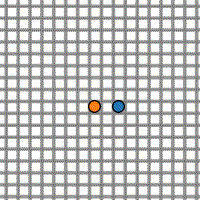This is the repository for the paper:
Michael A. Alcorn and Anh Nguyen.
baller2vec++: A Look-Ahead Multi-Entity Transformer For Modeling Coordinated Agents. arXiv. 2021.
 |
 |
 |
|---|---|---|
| Training sample | baller2vec |
baller2vec++ |
When trained on a dataset of perfectly coordinated agent trajectories, the trajectories generated by baller2vec are completely uncoordinated while the trajectories generated by baller2vec++ are perfectly coordinated.
 |
 |
 |
 |
|---|---|---|---|
| Ground truth | baller2vec |
baller2vec |
baller2vec |
 |
 |
 |
 |
| Ground truth | baller2vec++ |
baller2vec++ |
baller2vec++ |
While baller2vec occasionally generates realistic trajectories for the red defender, it also makes egregious errors.
In contrast, the trajectories generated by baller2vec++ often seem plausible.
The red player was placed last in the player order when generating his trajectory with baller2vec++.
If you use this code for your own research, please cite:
@article{alcorn2021baller2vec,
title={\texttt{baller2vec++}: A Look-Ahead Multi-Entity Transformer For Modeling Coordinated Agents},
author={Alcorn, Michael A. and Nguyen, Anh},
journal={arXiv preprint arXiv:2104.11980},
year={2021}
}
After you've cloned the repository to your desired location, create a file called .basketball_profile in your home directory:
nano ~/.basketball_profileand copy and paste in the contents of .basketball_profile, replacing each of the variable values with paths relevant to your environment.
Next, add the following line to the end of your ~/.bashrc:
source ~/.basketball_profileand either log out and log back in again or run:
source ~/.bashrcYou should now be able to copy and paste all of the commands in the various instructions sections. For example:
echo ${PROJECT_DIR}should print the path you set for PROJECT_DIR in .basketball_profile.
cd ${PROJECT_DIR}
pip3 install --upgrade -r requirements.txt- Copy
events.zip(which I acquired from here [mirror here] using https://downgit.github.io) to theDATA_DIRdirectory and unzip it:
mkdir -p ${DATA_DIR}
cp ${PROJECT_DIR}/events.zip ${DATA_DIR}
cd ${DATA_DIR}
unzip -q events.zip
rm events.zipDescriptions for the various EVENTMSGTYPEs can be found here (mirror here).
cd ${DATA_DIR}
git clone git@github.com:linouk23/NBA-Player-Movements.gitA description of the tracking data can be found here.
cd ${PROJECT_DIR}
nohup python3 generate_game_numpy_arrays.py > data.log &You can monitor its progress with:
topor:
ls -U ${GAMES_DIR} | wc -lThere should be 1,262 NumPy arrays (corresponding to 631 X/y pairs) when finished.
Run (or copy and paste) the following script, editing the variables as appropriate.
#!/usr/bin/env bash
JOB=$(date +%Y%m%d%H%M%S)
echo "train:" >> ${JOB}.yaml
task=basketball # "basketball" or "toy".
echo " task: ${task}" >> ${JOB}.yaml
if [[ "$task" = "basketball" ]]
then
echo " train_samples_per_epoch: 20000" >> ${JOB}.yaml
echo " valid_samples: 1000" >> ${JOB}.yaml
echo " workers: 10" >> ${JOB}.yaml
echo " learning_rate: 1.0e-5" >> ${JOB}.yaml
echo " patience: 20" >> ${JOB}.yaml
echo "dataset:" >> ${JOB}.yaml
echo " hz: 5" >> ${JOB}.yaml
echo " secs: 4.2" >> ${JOB}.yaml
echo " player_traj_n: 11" >> ${JOB}.yaml
echo " max_player_move: 4.5" >> ${JOB}.yaml
echo "model:" >> ${JOB}.yaml
echo " embedding_dim: 20" >> ${JOB}.yaml
echo " sigmoid: none" >> ${JOB}.yaml
echo " mlp_layers: [128, 256, 512]" >> ${JOB}.yaml
echo " nhead: 8" >> ${JOB}.yaml
echo " dim_feedforward: 2048" >> ${JOB}.yaml
echo " num_layers: 6" >> ${JOB}.yaml
echo " dropout: 0.0" >> ${JOB}.yaml
echo " b2v: False" >> ${JOB}.yaml
else
echo " workers: 10" >> ${JOB}.yaml
echo " learning_rate: 1.0e-4" >> ${JOB}.yaml
echo "model:" >> ${JOB}.yaml
echo " embedding_dim: 20" >> ${JOB}.yaml
echo " sigmoid: none" >> ${JOB}.yaml
echo " mlp_layers: [64, 128]" >> ${JOB}.yaml
echo " nhead: 4" >> ${JOB}.yaml
echo " dim_feedforward: 512" >> ${JOB}.yaml
echo " num_layers: 2" >> ${JOB}.yaml
echo " dropout: 0.0" >> ${JOB}.yaml
echo " b2v: True" >> ${JOB}.yaml
fi
# Save experiment settings.
mkdir -p ${EXPERIMENTS_DIR}/${JOB}
mv ${JOB}.yaml ${EXPERIMENTS_DIR}/${JOB}/
gpu=0
cd ${PROJECT_DIR}
nohup python3 train_baller2vecplusplus.py ${JOB} ${gpu} > ${EXPERIMENTS_DIR}/${JOB}/train.log &